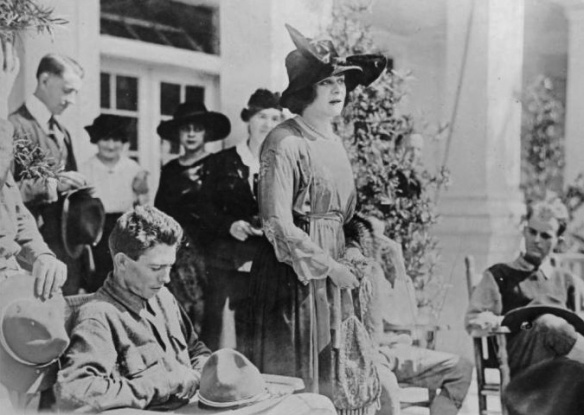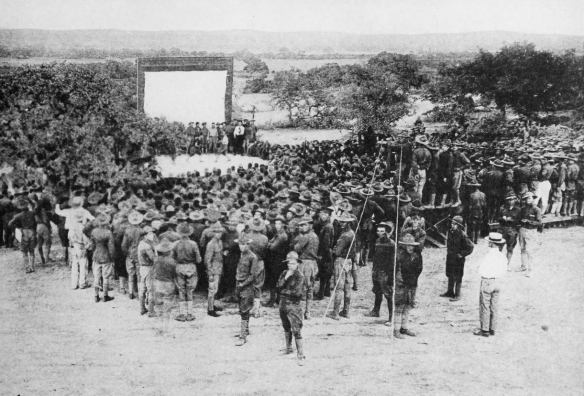Dismissed as an insipid novelty less than a decade earlier, the film medium flexed its muscles during World War I as it never had before. Movies documented life in the trenches for eager audiences on the home front… while conveniently concealing gory realities. They cheered the hearts of those fighting the battles. They even helped to turned the tide by persuasively prodding America into the fray.
The war also forever altered the landscape of film production and distribution, decimating European national cinemas and establishing Hollywood as the industry’s juggernaut. Screenwriter Anita Loos observed, Hollywood “was an outcome of an economic situation created by war.” If the conflict shaped Hollywood, Hollywood shaped the war, as well. Propaganda pictures moulded public opinion with “real-life footage” actually shot on California sound stages. Movie stars, still a relatively new phenomenon, drew massive crowds and raised even more massive amounts of money for the war effort, demonstrating the unprecedented power of celluloid fame.
So, without further ado, I invite you to ponder these images, gleaned from a variety of sources, that convey the multi-faceted significance of film and filmdom during WWI.
 Douglas Fairbanks, Mary Pickford, and Charlie Chaplin insist that every part of America should make a contribution to the war effort by buying Liberty Bonds. (And, is it just me, or is Charlie giggling over Florida’s phallic shape?)
Douglas Fairbanks, Mary Pickford, and Charlie Chaplin insist that every part of America should make a contribution to the war effort by buying Liberty Bonds. (And, is it just me, or is Charlie giggling over Florida’s phallic shape?)

The irrepressibly likable Douglas Fairbanks engages a sea of spectators while talking up the third Liberty Loan in front of the Sub-Treasury building in New York City. (Image via Wikimedia Commons.)
As the actor’s son, Douglas Fairbanks Jr. remembered, “When my father tried to join up [for active service] he was personally written to by President Wilson at the time who said ‘For heaven’s sake, we’re not going to let you do that because you can do much, much more for the country by raising these vast sums which nobody else can do.'”

Mary Pickford stirs up a crowd with her patriotic rhetoric at a Liberty Bond rally in Washington, D.C. on April 6, 1918. A single speech from Little Mary could harvest some big cash—millions in a day. Image from the Library of Congress [Source].

Doug and Mary pose with relief packages. Another image from the Library of Congress [Source].

Fairbanks, Pickford, and Chaplin make an appearance in Philadelphia, lobbying support and funds for the third Liberty Loan drive.

Silent film actress Edith Storey knits a sweater for her brother in the Navy, while wearing a Russian Army uniform for her latest film. Wartime fan magazines often shared images of female stars working at their needles—in the hopes that their legions of fans would follow suit and contribute warm woolens for the boys overseas.

The silent screen’s original vamp, Theda Bara visits a ward of wounded veterans. Though famous for playing carnivorous femmes fatales, the actress revealed her heart of gold by raising money for the war effort and visiting army camps to raise morale. (Image from the Academy of Motion Picture Arts and Sciences)

This image showing Private Keaton of the Fortieth ‘Sunshine’ Division suggests that even the Great War couldn’t make a dent in Buster’s poker face. Still, the silent clown recalled his frustration with the fact that the U.S. Army clearly didn’t design uniforms with men of his build (a lean 5’5″) in mind; his standard-issue outfit made him “look and feel ridiculous.”
Although Keaton applied himself dutifully to army life, he reported in his memoirs, “It was not always possible to take that war seriously. In the first place, I could not understand why we, the French, and the English were fighting the Germans and the Austrians. Being in vaudeville all my life had made me international-mided. I had met too many kindly German performers—singers and acrobats and musicians—to believe they could be as evil as they were being portrayed in our newspapers. Having known Germans, Japanese jugglers, Chinese magicians, Italian tenors, Swiss yodelers and bell-ringers, Irish, Jewish, and Dutch comedians, British dancers, and whirling dervishes from India, I believed people from everywhere in the world were about the same. Not as individuals, of course, but taken as a group.”
Image from Wikimedia Commons via this article about Keaton’s service in WWI, which I recommend.

Speaking of comedians… Max Linder, the ground-breaking French comic (right), convalescing from a major injury at an army hospital and holding hands with, I believe, a member of a Senegalese tirailleur unit. The first international film star, Linder projected a dandyish screen image and was known for his ubiquitous silk top hat—he’s all but unrecognizable in this cloth cap and ragtag bundle of clothes. Sadly, Linder’s career would suffer from the decline of the French film industry following the war; he directed and starred in feature-length comedies in the United States, but met with only limited success among American audiences.

Carl Laemmle, founder of Universal Studios, solemnly works under a service flag decorated with a star for each studio employee in the military—and there are 217 of them. German-born Laemmle, aiming to distance himself from a background which made him a possible target for prejudice and even boycotting, green-lit some of the most virulent anti-Hun propaganda films of the era. Years later, however, his studio would produce the acclaimed WWI drama All Quiet on the Western Front, which expresses a poignant anti-war message through its sympathetic German protagonist.

Pickford in uniform? Did she single-handledly win WWI like she seems to do in the movies? Well, no, but she was the honorary colonel and “godmother” of a regiment, the 143rd Field Artillery, jokingly referred to as “Mary’s Lambs.”
A uniformed Pickford also presided over a group of studio employees known as the Lasky Home Guard who vowed to enlist and serve their country. As Agnes de Mille remembered, she “wore a splendid couturier’s outfit of patriotic grey with a little veil down the back. She looked splendid… and sent them to death very valiantly. The grisly part is some did go to death.”

Two volunteers with the YMCA use a portable projector to show movies to an audience of soldiers in France.
In the Photoplay article that accompanied this image, Janet Cummings of the overseas YMCA service extolled the importance of movies to American troops: “Film has been the recruiting sergeant, the drillmaster, the morale-strengthener and the faithful comrade-in-arms of this country’s army in cantonment, on board transport, in front line camp, in the zone of the rear and in hospital.”

American sailors crowd in to enjoy a comedy projected on their battleship’s patch.

An open-air movie theater in an American army encampment. In this picture, however, no movie is playing. A boxing match is taking place on the stage in front of the screen instead.
Interestingly enough, the price of admission to screenings “over there” cost five or ten cents for an enlisted man. Many soldiers couldn’t spare a nickel, so Americans on the home front helped them out by buying and donating movie vouchers. At the time, railroads sold mileage booklets that would enable a traveler to ride for a certain distance. Hence, the film vouchers were affectionately called “smilage” booklets—letting the troops smile and forget their cares for an hour or so.

Second-Lieutenant A.H.C. Sintzenich of the U.S. Signal Corps prepares to record some footage with his Debrie camera from a light railway track in Sussex, England…
 …and now Sintzenich braces himsele to take off and capture some aerial shots.
…and now Sintzenich braces himsele to take off and capture some aerial shots.

D.W. Griffith (wearing a bow-tie) visits an active battlefield sector in France—just 50 yards away from the German lines—while developing his wartime drama Hearts of the World. Invited to Europe by the British government, Griffith was the only film director allowed to tour the trenches. (Previous three images from the National Archives and Records Administration.)
Yet, Griffith witnessing war firsthand—after faking it so often on film—described the experience as an anticlimax:
“It was exactly as I had imagined wars in many particulars. I saw, for instance, many troop trains moving away to the front. I saw wives parting from husbands they were never to see again. I saw wounded men returning to their families. I saw women coming away from the government offices, stunned with grief, a little paper in their hands to tell that the worst had happened.
“All these things were so exactly as we had been putting them on in the pictures for years and years that I found myself sometimes absently wondering who was staging the scene.”
~ ~ ~
Please note that most images with no specified source were cropped and edited (by me) from digitized issues of Photoplay magazine, for which I gratefully acknowledge the Media History Digital Library.
